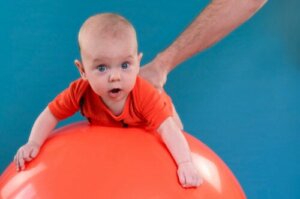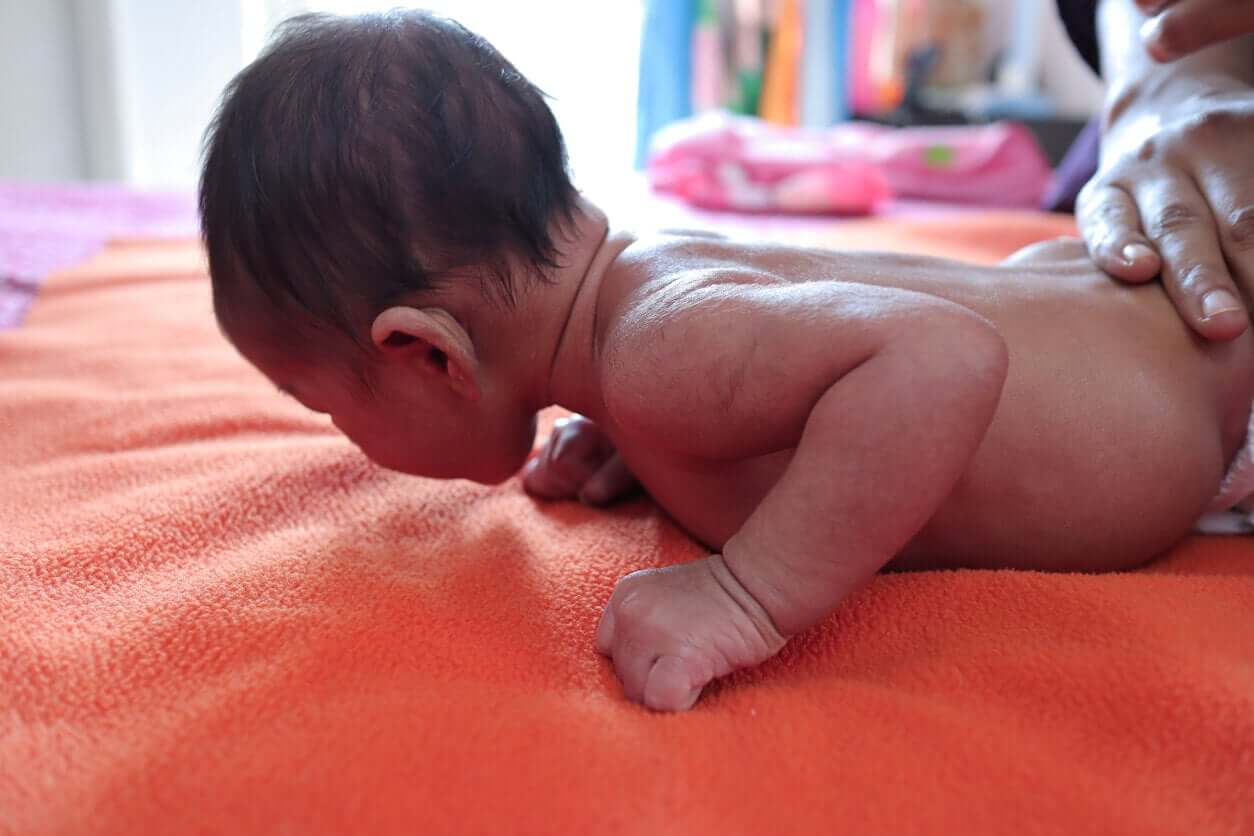4 Exercises That Help Babies Hold Up Their Heads

It’s difficult for babies to hold up their heads during the first months of life, as they’re born with some weakness in his muscular structures. For this reason, it’s a good idea to implement a series of exercises in order to help newborns in this complex task.
It’s important to note that the optimal position to perform each activity depends on the child’s maturation stage, in order to achieve the greatest benefit without forcing or damaging their delicate body.
Below, we’ll share some exercises that you can start enjoying with your little one today.
Exercises to encourage babies to hold up their heads
Exercises to promote head support start from the child’s spontaneous movements. At this stage, the brain is very sensitive to them and each change in position helps to stimulate all muscle groups. Therefore, any motor effort is welcome when working and strengthening the baby’s locomotor system.
Regarding head support, the structures that actively participate in it are the neck, shoulders, and the upper and middle areas of the back.
With that in mind, the stimulation on these areas allows the child to increase their muscle tone and execute movements of greater and greater complexity.
We’ll share some ideas to work your baby’s muscles. Take note!
1. Lay them face down

This exercise is one of the first to be done to promote structural strengthening. Although it’s a position that must be adopted throughout childhood, it’s particularly important in the first months of life.
You should note that this exercise should only be carried out in waking moments, under the constant supervision of an adult, and on a firm surface that’s well isolated from the ground. For example, on an Eva floor mat or a yoga mat. It’s not a good idea to practice it on the bed or on the table, due to the risk of falls.
In this position, the baby’s forced to contract the dorsal and lumbar muscles to raise their head from the surface. However, this tension alternates with moments of relaxation constantly, so you need to make sure that their face doesn’t land against the floor.
In addition to the muscular structures of the neck, the shoulders also come into play in this position. Especially when the child manages to rise even higher and bring their arms forward.
Many children get annoyed with this position quickly, so it’s important to stay alert and end the activity at the slightest sign of discomfort.
You may be interested: When to Put Your Baby On Their Tummy?
2. Move their arms in different positions to help babies hold their heads up
The movement of the arms can be worked on in two main positions, face up and face down. We recommend that you start with the baby lying on their back because it’s the simplest way.
From the lying position, you must take both hands of the baby. Take advantage of the palmar grasping reflex typical of this stage to make the task easier. Then start moving your arms harmoniously and in different directions: Up and down and continue to the sides.
It’s important that you don’t pull on their limbs so much that you lift the child from the surface. Simply limit yourself to mobilizing them.
In order to make the exercise more complex, you can also place the baby on their stomach and for this, we recommend that you support their chest on a cushion. Placed in that position, take their hands again and try to move them up and down, very slowly.
3. Capture their attention with an eye-catching object
The flashy object exercise focuses on the visual stimulation of the baby. To carry it out, you can use any element you want: A toy, a ball, some colorful fruit, etc. The important thing is that it be of interest to the child.
Then, you should position yourself at a distance that’s within the baby’s field of vision, about 15 to 20 inches from their face. Ideally, they shouldn’t be able to reach the object with their hands.
Move the element from right to left and vice versa, also up and down or in circles. The objective of this movement is for the baby to follow it with their eyes, move their head, and stimulate the muscles in the area to gradually strengthen them.
If the baby reaches out to reach for the element, this makes the exercise even better. This way, the work of the shoulders and the back muscles increases.
4. Alternate between facing up and facing down
After the first three months of age, the baby can perform more complex movements. In this case, you can do with him an exercise similar to that of conventional abdominals.
To do this, the baby must be lying on their back. Take them by both hands and help them lift their torso harmoniously and slowly. Ideally, you should remain with your hands steady and allow the baby to make the effort to rise.
At the end of the torso flex, bring the baby back down in the same way. You can do this exercise twice a day with a reduced number of repetitions.
Remember that the movements must be smooth so as not to strain the child’s joints too much and thus cause damage.

The importance of helping babies hold their heads up
Structural strengthening of the neck, back, and shoulders of babies not only helps to support their head. It also provides another series of benefits linked to the development of speech and nutrition.
Other than that, your baby is likely to start gaining autonomy in body movement much earlier than you expect. Such strengthening also provides countless benefits for learning basic locomotion patterns: Crawling and walking.
It’s difficult for babies to hold up their heads during the first months of life, as they’re born with some weakness in his muscular structures. For this reason, it’s a good idea to implement a series of exercises in order to help newborns in this complex task.
It’s important to note that the optimal position to perform each activity depends on the child’s maturation stage, in order to achieve the greatest benefit without forcing or damaging their delicate body.
Below, we’ll share some exercises that you can start enjoying with your little one today.
Exercises to encourage babies to hold up their heads
Exercises to promote head support start from the child’s spontaneous movements. At this stage, the brain is very sensitive to them and each change in position helps to stimulate all muscle groups. Therefore, any motor effort is welcome when working and strengthening the baby’s locomotor system.
Regarding head support, the structures that actively participate in it are the neck, shoulders, and the upper and middle areas of the back.
With that in mind, the stimulation on these areas allows the child to increase their muscle tone and execute movements of greater and greater complexity.
We’ll share some ideas to work your baby’s muscles. Take note!
1. Lay them face down

This exercise is one of the first to be done to promote structural strengthening. Although it’s a position that must be adopted throughout childhood, it’s particularly important in the first months of life.
You should note that this exercise should only be carried out in waking moments, under the constant supervision of an adult, and on a firm surface that’s well isolated from the ground. For example, on an Eva floor mat or a yoga mat. It’s not a good idea to practice it on the bed or on the table, due to the risk of falls.
In this position, the baby’s forced to contract the dorsal and lumbar muscles to raise their head from the surface. However, this tension alternates with moments of relaxation constantly, so you need to make sure that their face doesn’t land against the floor.
In addition to the muscular structures of the neck, the shoulders also come into play in this position. Especially when the child manages to rise even higher and bring their arms forward.
Many children get annoyed with this position quickly, so it’s important to stay alert and end the activity at the slightest sign of discomfort.
You may be interested: When to Put Your Baby On Their Tummy?
2. Move their arms in different positions to help babies hold their heads up
The movement of the arms can be worked on in two main positions, face up and face down. We recommend that you start with the baby lying on their back because it’s the simplest way.
From the lying position, you must take both hands of the baby. Take advantage of the palmar grasping reflex typical of this stage to make the task easier. Then start moving your arms harmoniously and in different directions: Up and down and continue to the sides.
It’s important that you don’t pull on their limbs so much that you lift the child from the surface. Simply limit yourself to mobilizing them.
In order to make the exercise more complex, you can also place the baby on their stomach and for this, we recommend that you support their chest on a cushion. Placed in that position, take their hands again and try to move them up and down, very slowly.
3. Capture their attention with an eye-catching object
The flashy object exercise focuses on the visual stimulation of the baby. To carry it out, you can use any element you want: A toy, a ball, some colorful fruit, etc. The important thing is that it be of interest to the child.
Then, you should position yourself at a distance that’s within the baby’s field of vision, about 15 to 20 inches from their face. Ideally, they shouldn’t be able to reach the object with their hands.
Move the element from right to left and vice versa, also up and down or in circles. The objective of this movement is for the baby to follow it with their eyes, move their head, and stimulate the muscles in the area to gradually strengthen them.
If the baby reaches out to reach for the element, this makes the exercise even better. This way, the work of the shoulders and the back muscles increases.
4. Alternate between facing up and facing down
After the first three months of age, the baby can perform more complex movements. In this case, you can do with him an exercise similar to that of conventional abdominals.
To do this, the baby must be lying on their back. Take them by both hands and help them lift their torso harmoniously and slowly. Ideally, you should remain with your hands steady and allow the baby to make the effort to rise.
At the end of the torso flex, bring the baby back down in the same way. You can do this exercise twice a day with a reduced number of repetitions.
Remember that the movements must be smooth so as not to strain the child’s joints too much and thus cause damage.

The importance of helping babies hold their heads up
Structural strengthening of the neck, back, and shoulders of babies not only helps to support their head. It also provides another series of benefits linked to the development of speech and nutrition.
Other than that, your baby is likely to start gaining autonomy in body movement much earlier than you expect. Such strengthening also provides countless benefits for learning basic locomotion patterns: Crawling and walking.
All cited sources were thoroughly reviewed by our team to ensure their quality, reliability, currency, and validity. The bibliography of this article was considered reliable and of academic or scientific accuracy.
- Rescatado de la página web Healthy Children. (2009). https://www.healthychildren.org/Spanish/ages-stages/baby/Paginas/Newborn-Reflexes.aspx
- Walker SP, Chang SM, Vera-Hernández M y Grantham-McGregor S. (2011). La estimulación infantil temprana beneficia la competencia del adulto y reduce el comportamiento violento. https://www.sap.org.ar/docs/publicaciones/archivosarg/2011/v109n4a22.pdf
This text is provided for informational purposes only and does not replace consultation with a professional. If in doubt, consult your specialist.








